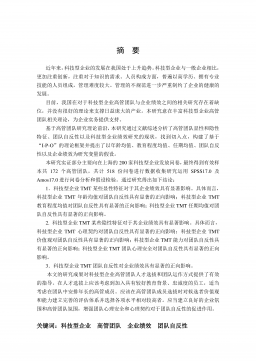弹簧支撑管壳式换热器流动换热及诱导振动特性研究
VIP免费
摘 要
纵流程管壳式换热器是近些年来管壳式换热器研究的一种重要方向,相较于
弓形折流板管壳式换热器管、壳侧流体横向流动的特性,纵流程换热器可实现管、
壳侧流体全逆流流动,有效地消除传热死区,降低压降,这就意味着可用体积较
小的换热器达到同样的热负荷,降低运行费用。另外,这种换热器在防止诱导振
动方面也有非常优秀的表现。因此吸引了国内外众多研究投入到对其的研究中,
本文绪论中作了详细介绍。本课题涉及的弹簧支撑管壳式换热器是一种新型的纵
流程管壳式换热器,它采用弹簧代替折流板作为管束的支撑结构,同时又可起到
强化换热的目的。
本文首先建立起弹簧支撑管壳式换热器数学物理模型。对换热器物理模型进
行了若干简化处理:根据流体在换热器中流动特性,把研究对象简化为弹簧支撑
管壳式换热器的一个单元流道;计算流道当量直径时考虑了弹簧结构的影响等;
使用 ICEM 划分单元流道网格,对于不同的表面,采用不同的网格尺寸,在不影
响计算结果的前提下,降低对计算资源的要求。在网格划分完毕后,对弹簧支撑
弹簧支撑管壳式换热器的流动和换热特性进行了研究:分析了弹簧前后间距、弹
簧螺距、弹簧支撑长度对壳侧对流换热系数和压降的影响,比较了弹簧支撑和折
流板支撑下换热器的综合性能的优劣;运用多元线性回归拟合出了弹簧支撑管壳
式换热器努赛尔数 Nu 和阻力系数 f的关联式。
然后运用遗传算法,借助 MATLAB 软件对弹簧支撑管壳式换热器进行优化设
计,以投资运行的总费用为目标函数,弹簧前后间距、弹簧螺距、弹簧支撑长度,
壳侧直径为变量,经过编程,最终得出了给定换热量下弹簧支撑管壳式换热器的
结构参数。
最后,建立四组换热器管束的三维模型,研究其在不同弹簧前后间距、不同
弹簧螺距、不同弹簧支撑长度、不同弹簧组组数情况下诱导振动情况进行了分析,
主要是借助 ANSYS 软件的模态分析模块进行换热管束的模态分析即固有频率和
振型的分析;简单介绍了管束振动的数学模型,模态分析方法等内容;结合前人
研究成果和本课题的数据,提出防止弹簧支撑管壳式换热器诱导振动的若干措施。
关键词:弹簧支撑 场协同 强化传热 优化设计 诱导振动
ABSTRACT
Longitudinal flow heat exchanger has become an important research branch of
tube-and-shell heat exchanger in recent years. Compared to segmental baffle
tube-and-shell heat exchanger’s cross flow characteristic between shell side and tube
side, longitudinal flow heat exchanger can achieve an totally counter-flow between the
two different fluids, thus it avoid the heat transfer ‘Dead Space’ and reduce the pressure
drop, it means we can use a smaller heat exchanger to meet the same heat load
requirement and thus decreases the operation cost. Additionally, heat exchanger of this
kind has excellent performance in avoiding induced vibration. For the advantages
mentioned above, more and more researchers at home and abroad begin to do the
related subjects in this field, this has been described in preface in detail. The
tube-and-shell heat exchanger supported by springs involved in this paper is a new
Longitudinal flow heat exchanger type, it uses groups of springs rather than segmental
baffles to support the tubes and at the same time, enhances the heat transfer process.
Firstly, the mathematic and physical models of tube-and-shell heat exchanger
supported by springs are established. Here by several means simplifies the physical
model: According to the flow characteristics of fluid in the heat exchanger, an unit flow
channel is taken as the research objective, the influence of spring structure parameter is
taken into consideration when the calculation result data is dealt with and so on. Use
ICEM to draw the non-construction grid of the unit channel, different faces have
different grid parameter definition, thus it guarantees that the lowest computation
resource is needed in the premise that the calculation result is right. After drawing the
grid, the flow and heat transfer characteristics of tube-and-shell heat exchanger
supported by springs is researched. The subject analyses the variation of spring group
pitch, spring screw pitch, spring length’s influence to convective heat transfer
coefficient and pressure drop, next compare the comprehensive performance between
the segmental tube-and-shell heat exchanger and the tube-and-shell heat exchanger
supported by springs ;use multiple linear regression fit the Nu and f equation.
Next, An optimization calculation is carried out using the genetic algorithm by
MATLAB. In the chapter, the total investment and operation cost is taken as the
objective function, variables are shell diameter, spring group pitch, spring screw pitch
and spring length. Through programming, the optimal heat exchanger parameter under a
certain thermal load is obtained.
At last, establish the three dimension heat exchanger model, give the induced
vibration research of a heat transfer tube bundle in different spring group pitch, spring
screw pitch,spring length and spring group number. The major work is to analyze the
heat transfer bundle’s modal analysis characteristics, namely, natural frequency and
vibrational modes. Give a general vibration mathematic model and modal analysis
method and so on. Combining with former research result and data in this subject,
propose several measures to prevent the induced vibration of tube-and-shell heat
exchanger supported by springs.
Key Word: supported by springs, field synergy, heat transfer
enhancement, induced vibration
目 录
中文摘要
ABSTRACT
第一章 绪论 .................................................................................................................... 1
1.1 前言 ........................................................................................................................ 1
1.2 纵流壳程换热器的研究现状 ................................................................................ 2
1.2.1 空心环 ............................................................................................................. 2
1.2.2 折流杆 ............................................................................................................. 3
1.2.3 螺旋折流板 ..................................................................................................... 3
1.2.4 整圆形板 ......................................................................................................... 5
1.2.5 螺旋扭片 ......................................................................................................... 6
1.2.6 管束自支撑 ..................................................................................................... 6
1.3 换热器优化设计研究现状 .................................................................................... 7
1.4 换热器诱导振动研究现状 .................................................................................... 8
1.5 本课题拟完成的工作 .......................................................................................... 10
第二章 弹簧支撑管壳式换热器的数学物理模型 ....................................................... 11
2.1 物理模型的简化及相关假设 ............................................................................... 11
2.2 数学模型 ............................................................................................................... 12
2.3 湍流模型 ............................................................................................................... 13
2.4 边界条件 ............................................................................................................... 14
2.5 几何模型 ............................................................................................................... 14
2.6 模型的网格划分 ................................................................................................... 15
2.7 SOLVER 设置 ....................................................................................................... 16
2.8 当量直径的处理 ................................................................................................... 17
2.9 参数定义 ............................................................................................................... 18
2.10 本章小结 ............................................................................................................. 19
第三章 弹簧支撑管壳式换热器流动与传热研究 ...................................................... 20
3.1 流场及温度场分析 .............................................................................................. 20
3.1.1 速度场分布 ................................................................................................... 20
3.1.2 温度分布 ....................................................................................................... 21
3.1.3 场协同分析 ................................................................................................... 22
3.2 弹簧前后间距变化 .............................................................................................. 24
3.3 弹簧螺距变化 ...................................................................................................... 26
3.4 弹簧长度变化 ...................................................................................................... 27
3.5 回归分析 .............................................................................................................. 28
3.5.1 回归介绍 ....................................................................................................... 28
3.5.2 关联式的拟合 ............................................................................................... 31
3.6 性能评价指标比较 .............................................................................................. 32
3.7 本章小结 ............................................................................................................... 34
第四章 弹簧支撑管壳式换热器的优化设计 .............................................................. 36
4.1 遗传算法 .............................................................................................................. 36
4.2 数学模型的建立 .................................................................................................. 38
4.2.1 传热计算 ....................................................................................................... 38
4.2.2 压降计算 ....................................................................................................... 40
4.2.3 目标函数 ....................................................................................................... 40
4.3 优化计算 .............................................................................................................. 41
4.4 本章小结 .............................................................................................................. 42
第五章 换热器管束诱导振动分析 .............................................................................. 44
5.1 管子的振动方程 .................................................................................................. 44
5.1.1 振动方程 ....................................................................................................... 44
5.1.2 方程的解 ....................................................................................................... 45
5.2 模态分析 .............................................................................................................. 46
5.3 ANSYS MODAL 介绍 ......................................................................................... 46
5.4 振动分析的物理模型及边界条件设置 ............................................................... 48
5.5 振动结果分析 ...................................................................................................... 48
5.5.1 弹簧长度变化 ............................................................................................... 48
5.5.2 弹簧螺距变化 ............................................................................................... 49
5.5.3 弹簧组前后间距变化 .................................................................................... 49
5.5.4 弹簧组数变化 ............................................................................................... 51
5.6 防止诱导振动的措施 .......................................................................................... 53
5.7 本章小结 ............................................................................................................... 53
第六章 结 论 ............................................................................................................ 55
6.1 主要结论 .............................................................................................................. 55
6.2 课题总结 .............................................................................................................. 56
6.2.1 课题的不足之处 ........................................................................................... 56
6.2.2 特色之处 ........................................................................................................ 56
符号 ................................................................................................................................ 57
参考文献 ........................................................................................................................ 58
在读期间公开发表论文和承担的科研项目及取得成果 ............................................ 62
致谢 ................................................................................................................................ 63
相关推荐
-
七年级数学下册(易错30题专练)(沪教版)-第13章 相交线 平行线(原卷版)VIP免费
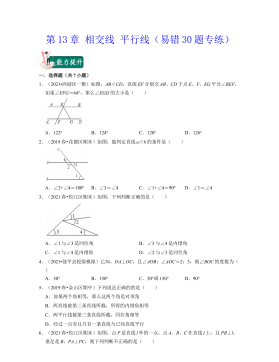
 2024-10-14 25
2024-10-14 25 -
七年级数学下册(易错30题专练)(沪教版)-第13章 相交线 平行线(解析版)VIP免费
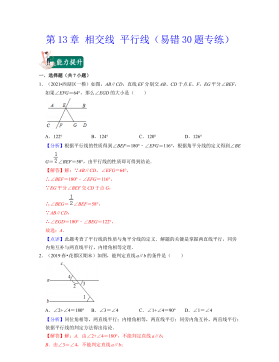
 2024-10-14 28
2024-10-14 28 -
七年级数学下册(易错30题专练)(沪教版)-第12章 实数(原卷版)VIP免费
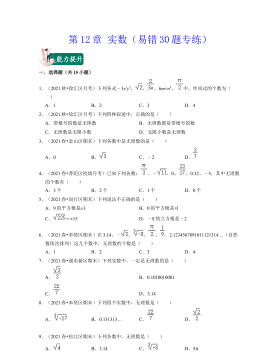
 2024-10-14 25
2024-10-14 25 -
七年级数学下册(易错30题专练)(沪教版)-第12章 实数(解析版)VIP免费
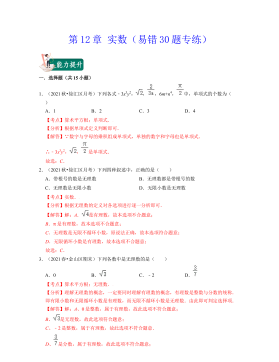
 2024-10-14 19
2024-10-14 19 -
七年级数学下册(压轴30题专练)(沪教版)-第15章平面直角坐标系(原卷版)VIP免费
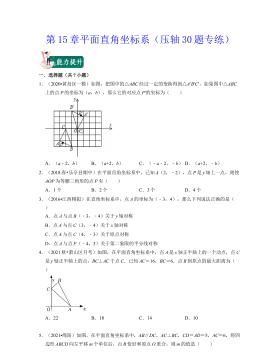
 2024-10-14 18
2024-10-14 18 -
七年级数学下册(压轴30题专练)(沪教版)-第15章平面直角坐标系(解析版)VIP免费

 2024-10-14 27
2024-10-14 27 -
七年级数学下册(压轴30题专练)(沪教版)-第14章三角形(原卷版)VIP免费

 2024-10-14 18
2024-10-14 18 -
七年级数学下册(压轴30题专练)(沪教版)-第14章三角形(解析版)VIP免费

 2024-10-14 30
2024-10-14 30 -
七年级数学下册(压轴30题专练)(沪教版)-第13章 相交线 平行线(原卷版)VIP免费
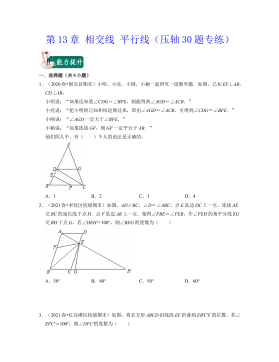
 2024-10-14 25
2024-10-14 25 -
七年级数学下册(压轴30题专练)(沪教版)-第13章 相交线 平行线(解析版)VIP免费
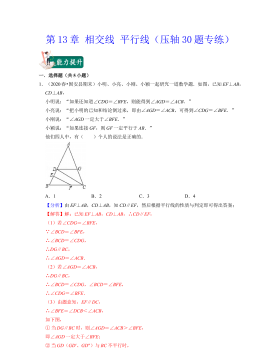
 2024-10-14 22
2024-10-14 22
作者:赵德峰
分类:高等教育资料
价格:15积分
属性:67 页
大小:3.57MB
格式:PDF
时间:2025-01-09
作者详情
相关内容
-

七年级数学下册(压轴30题专练)(沪教版)-第15章平面直角坐标系(原卷版)
分类:中小学教育资料
时间:2024-10-14
标签:无
格式:DOCX
价格:15 积分
-

七年级数学下册(压轴30题专练)(沪教版)-第15章平面直角坐标系(解析版)
分类:中小学教育资料
时间:2024-10-14
标签:无
格式:DOCX
价格:15 积分
-

七年级数学下册(压轴30题专练)(沪教版)-第14章三角形(原卷版)
分类:中小学教育资料
时间:2024-10-14
标签:无
格式:DOCX
价格:15 积分
-

七年级数学下册(压轴30题专练)(沪教版)-第14章三角形(解析版)
分类:中小学教育资料
时间:2024-10-14
标签:无
格式:DOCX
价格:15 积分
-

七年级数学下册(压轴30题专练)(沪教版)-第13章 相交线 平行线(原卷版)
分类:中小学教育资料
时间:2024-10-14
标签:无
格式:DOCX
价格:15 积分


